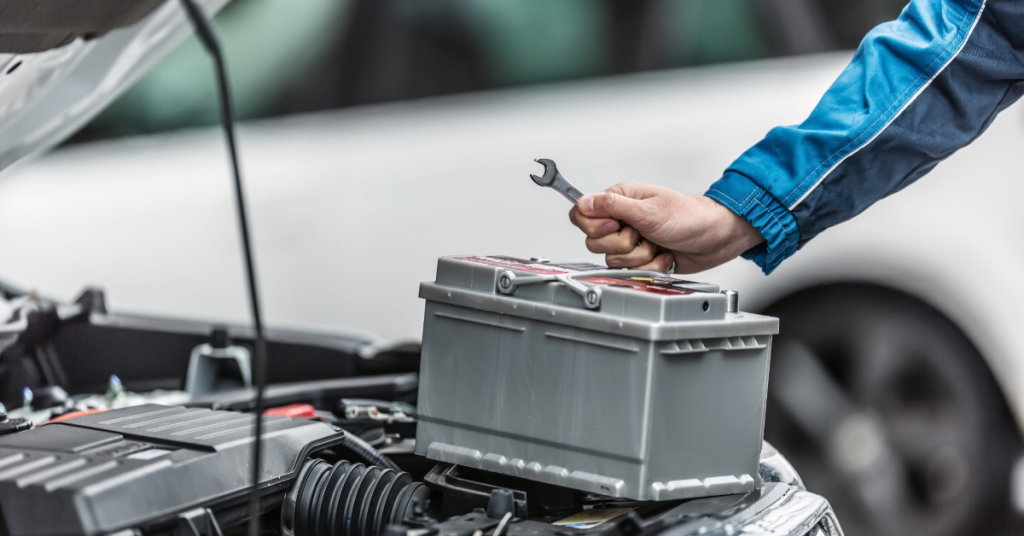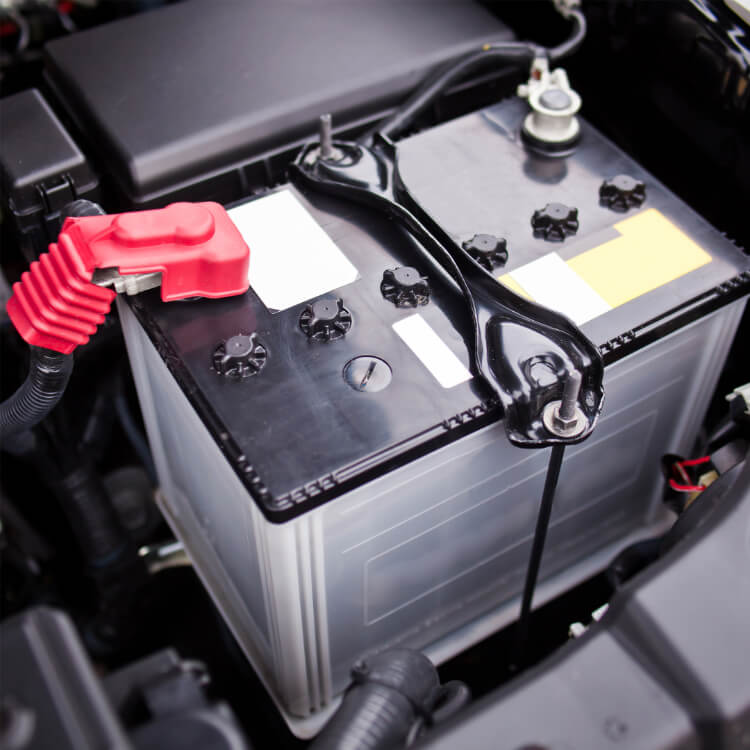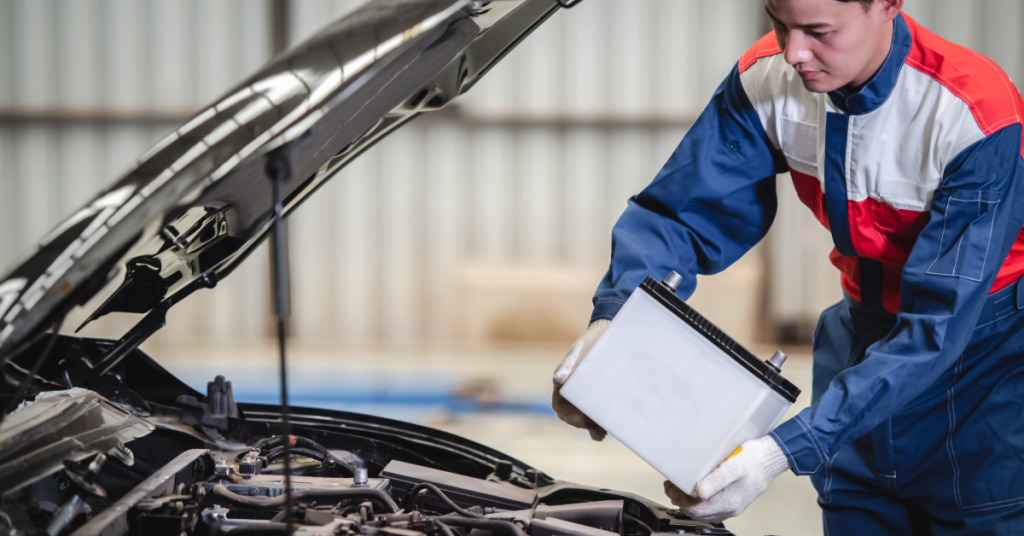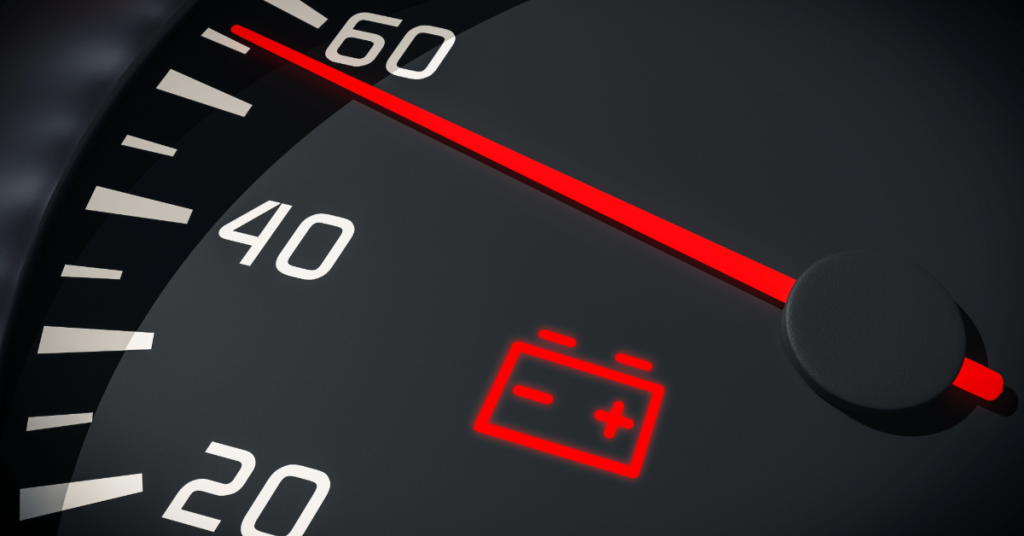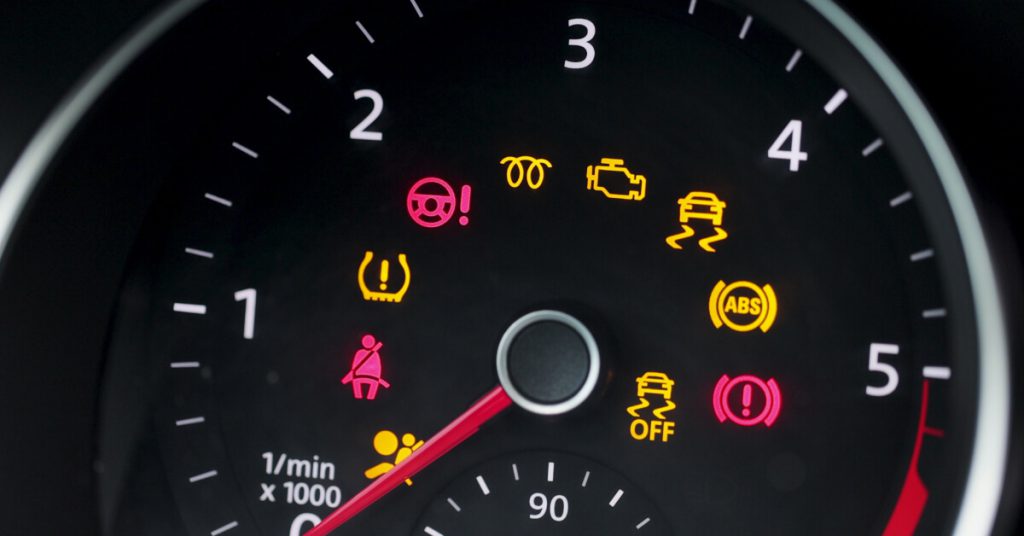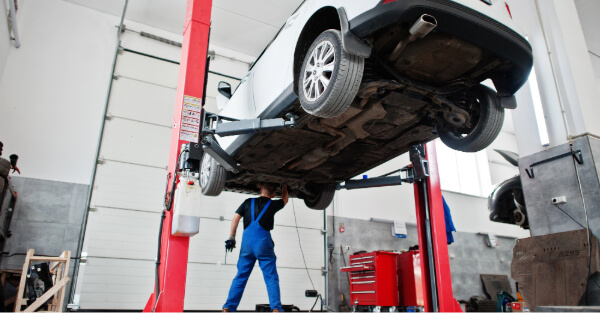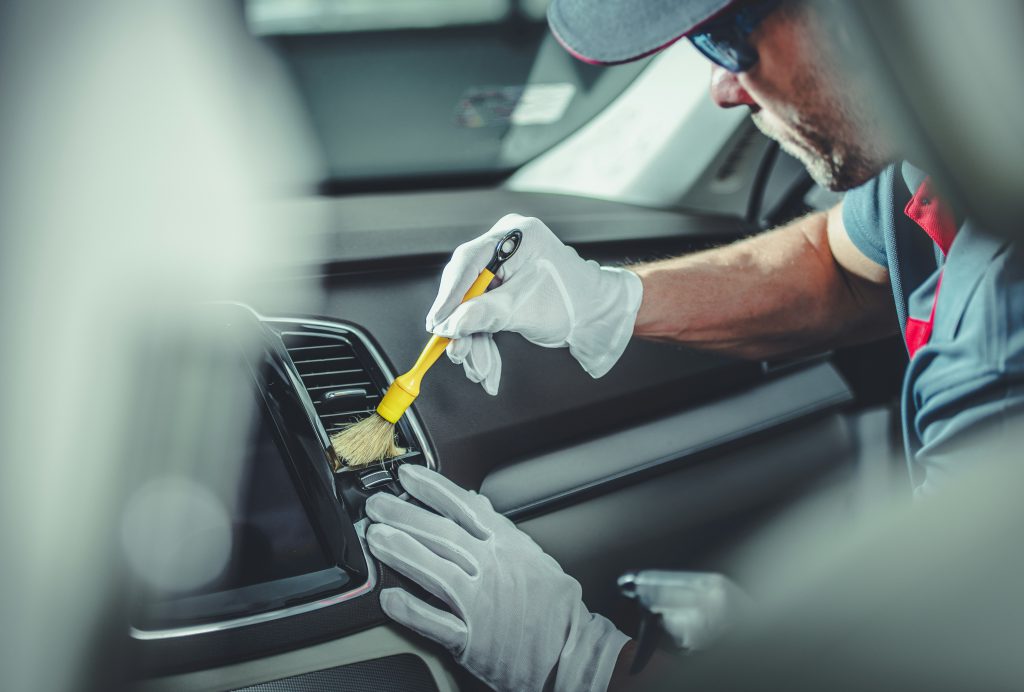Key Takeaways
- Understanding car battery basics and how to maintain it can help extend its life.
- Different types of batteries have varying lifespans, from 3-5 years for lead acid to 8-10 years for lithium ion.
- Get professional help if you notice signs like slow cranking, dimming headlights or a dashboard warning light – AAA and other trusted services offer testing, replacement & roadside assistance!
Understanding Car Battery Basics
Turning the key, you anticipate your car to spring into action. Ever wondered what makes this possible? It’s the car battery. This unsung hero under your hood does more than just starting the engine. It powers all the electrical components of your vehicle, from your headlights and radio to your GPS system. In essence, without a well-functioning battery, your car is as good as a large paperweight.
But do car batteries last forever? The average car battery life spans between 3 to 5 years. However, this can be influenced by various factors. Your driving habits, for instance, play a significant role. Taking short trips frequently can prevent the battery from fully recharging, reducing its lifespan. Weather conditions, especially high temperatures, can also have a negative impact, causing the battery to wear out faster. Comprehending these factors can play a significant role in prolonging your battery’s life.
The Role of Your Car’s Battery
What happens when you turn the ignition key? An orchestra of events unfolds under your car’s hood. The car battery takes center stage by providing the initial burst of energy to the starter, which in turn cranks the engine. But that’s not the end of its role. When the engine is off, it powers the accessories of your vehicle directly from its stored energy.
But what exactly comprises this essential component? A car battery, in essence, is a chemical energy storage device. It consists of positive and negative plates and an electrolyte, which stores energy in chemical form and turns it into electricity when needed. The inability of the battery to hold a charge signals the need for its replacement.
Average Car Battery Life Explained
Like any other component of your car, the battery also has a certain lifespan. On average, a car battery lasts between 3 to 5 years. But, it’s not set in stone. Several factors can influence this lifespan. One of the biggest culprits is heat. High temperatures can accelerate the chemical operation inside the battery and lead to faster wear and tear.
Yet, there is an upside to this. With proper maintenance, you can combat these factors and extend the life of your battery. Regular testing of your car battery can help you monitor its condition and address any potential issues promptly. A multimeter proves to be an effective tool for this task.
Types of Batteries and Their Lifespans
Not all car batteries are created equal. Different types of batteries come with various lifespans. How long do car batteries last? The most common type of battery is the lead-acid battery, which typically lasts between 3-5 years. AGM batteries, on the other hand, can last around 7 years, while lithium-ion batteries can have a lifespan of 8-10 years.
Choosing the right type of battery for your vehicle can help you maximize its performance and lifespan. But remember, regardless of the type, all batteries need proper care and maintenance. Regular check-ups, proper charging, and protection from extreme temperatures can help you get the most out of your car battery.
Prolonging Your Vehicle’s Battery Life
Having grasped the fundamentals of car batteries, we can now focus on ways to extend their lifespan. While we can’t control the weather, we can certainly control our driving habits. Avoiding short trips is one such habit. Why? Because short trips don’t give the car battery enough time to fully recharge. But what if you can’t avoid short trips? A portable car battery charger proves to be a reliable solution.
Another factor that plays a significant role in your battery’s lifespan is temperature. Extreme heat can cause the electrolyte in your battery to evaporate quickly, which can shorten the battery’s lifespan. Therefore, for those residing in hot climates, it’s advisable to park your car in shaded areas or garages to safeguard the battery.
Have you ever wondered why your car battery struggles in the hot weather? Heat accelerates the chemical reaction inside the battery, leading to faster wear and tear. This eventually shortens the lifespan of your car battery.
However, there are ways to combat the heat. Here are some tips:
- Regular driving can prevent your battery from discharging.
- Parking in the shade or using window covers to block out the heat can also help.
- Consistent washing and waxing can help avoid heat accumulation in your car.
- Lastly, inspecting the battery and its connections for any damage or corrosion can prevent any sudden breakdowns.
Keeping Your Battery Healthy: Maintenance Tips
After discussing factors affecting the battery’s lifespan, we should now concentrate on maintaining its health. Just like how we maintain our health with regular check-ups, our car battery also requires regular maintenance. This involves securely checking and fastening, routinely testing, and cleaning the terminals.
To ensure the proper functioning of your battery, follow these steps:
- Securely fasten the battery to prevent internal damage and short circuits, especially when driving on bumpy roads.
- Regularly test the battery to monitor its condition and promptly address any issues.
- Clean the terminals to prevent corrosion and maintain proper connectivity.
By following these steps, you can ensure the longevity and reliability of your battery.
Secure Checking and Fastening
You should regularly check the fastening of your car battery, ideally once a year. Should there be any loose connections, ensure to secure them. Remember, a securely fastened battery not only extends its lifespan but also prevents any potential damage to other car components.
Regular Testing to Assess Health
Regular testing is a key part of maintaining your car battery’s health. It helps you monitor its condition and address any potential issues promptly. But how do you test your car battery’s health? You’ll need a voltmeter and a battery tester.
For an accurate assessment of your car battery’s health, a multimeter comes in handy. It’s recommended to give your car battery a checkup at least twice a year or every 6 months or 6,000 miles. A healthy car battery should read 12.6 volts or above.
Cleaning Terminals to Maintain Connectivity
The terminals of your car battery are the point of contact between the battery and the electrical system of your car. But over time, these terminals can become corroded, affecting the flow of electricity. Cleaning these terminals can prevent corrosion and maintain proper connectivity.
So, how do you clean these terminals? Here’s a simple method:
- Create a mixture of baking soda and water.
- Apply the mixture to the terminals.
- Let it sit for a few minutes.
- Scrub it off with a brush or toothbrush.
Remember, clean terminals ensure a secure connection and allow for optimal battery performance and longevity.
Recognizing Signs of Battery Wear
Prevention is always better than cure. Early identification of battery wear signs can help avoid abrupt failures and expensive repairs. Some common warning signs include:
- Slow cranking
- Dimming headlights
- A visible dashboard warning light
- A swollen battery case
- A foul smell
When you notice these signs, it’s best to seek professional help. Overlooking these warning signs may result in a dead battery or even harm other car components. So, it’s always better to address these issues promptly.
Dashboard Warnings and Electrical Oddities
The dashboard is like a window into your car’s health. Warning lights on your dashboard may serve as an indication of car battery issues. Besides the battery light, other signs of a charging system problem could include dim headlights or the clock losing time.
If you notice a flickering dashboard light, it could mean that there’s something wrong with the car battery’s charging system. It could be something as simple as:
- corrosion on the battery terminals
- a loose or damaged alternator belt
- a faulty voltage regulator
- a failing alternator
Or it could be a more complex problem. So, when you see a warning light on your dashboard, don’t ignore it. Seek professional help to diagnose and fix the issue.
Engine Start-Up Delays
A delayed engine start-up is like a cry for help from your battery. It’s a clear sign that your car battery is running low on power and can’t provide a strong electrical current to the starter motor, possibly requiring a jump start.
Is there a delay each time you start your car? It’s time to take action. Begin by inspecting the car battery and its connections. If the battery is weak, you’ll need to replace it. If it’s in good condition, then it’s time to look at other components that could be causing the delay, such as:
- the starter
- starter relay
- fuel pump
- fuel filter
- fuel injectors
- alternator
Choosing the Right Replacement Battery
The selection of an appropriate replacement is critical when it’s time to change your car battery. But how do you do that? You need to understand battery group numbers and the importance of cold cranking amps (CCA) rating.
Battery group numbers tell you the:
- size
- hold down configuration
- type of terminals
- location of the battery
Selecting a new battery with the same group number as your previous one guarantees a correct fit and operation.
On the other hand, the CCA rating measures how much power the battery can deliver to start the engine at 0°F. Always opt for a battery with a CCA rating that is either equal to or exceeds the manufacturer’s recommendation.
Understanding Battery Group Numbers
Battery group numbers are like the ID cards of batteries. They tell you the physical dimensions and terminal placement of the battery. Selecting a battery with the same group number as your previous one guarantees a correct fit and operation.
A higher battery group number usually means the battery is physically larger. But remember, the battery group number doesn’t give any information about the capacity or voltage of the battery. While choosing a battery, make sure to choose one that fits well in your battery compartment and meets the necessary performance requirements.
Cold Cranking Amps (CCA) Rating Importance
The CCA rating of a battery is a crucial factor to consider when choosing a replacement battery. It measures how well the battery can deliver current in cold temperatures, specifically to start an engine.
A higher CCA rating means the battery has more power and can better handle the demands of starting a vehicle in cold weather. On the other hand, a lower CCA rating could result in difficulty starting the engine in really low temperatures.
So, when choosing a replacement battery, always go for one with a CCA rating equal to or higher than the manufacturer’s recommendation.
When to Seek Professional Help
Addressing car battery issues might prove challenging. But, you don’t have to do it alone. Professional help can come in handy when you notice warning signs that indicate potential battery issues. Trusted services like AAA can assist you in diagnosing and fixing these issues efficiently.
Professional services offer numerous advantages, including:
- Expertise to accurately diagnose and solve the issue
- Convenient roadside assistance
- Safe handling of batteries
- Quality service
- Assistance with warranty claims, potentially saving you money.
Warning Signs That Require Expert Attention
While it’s good to have some basic understanding of your car battery, there are times when it’s best to seek professional help. Warning signs like a slow engine crank, dim headlights, and a visible dashboard warning light could indicate a problem with your battery.
Neglecting these signs may result in expensive repairs or even a dead battery. If you notice these warning signs, it’s best to consult a professional. They can help diagnose the issue and suggest the best course of action.
Benefits of AAA and Other Trusted Services
Services such as AAA provide numerous advantages for car battery problems. They provide battery testing, replacement, and even deliver and install the battery for you.
Not just that, they also offer roadside assistance. So, if you ever have a problem with your car battery, you can give them a call, and they’ll send a technician to your location. The technician will take a look and try to fix it right then and there. If it can’t be fixed at the roadside, they may even tow your car to a repair facility for further diagnosis and repair.
Summary
To wrap up, understanding and maintaining your car battery is not rocket science. With a little knowledge about its role, lifespan, and the factors that affect it, you can prolong its life and prevent sudden breakdowns. Regular maintenance, such as securely fastening the battery, testing its health, and cleaning terminals, can help keep your battery in good condition. Paying attention to warning signs, choosing the right replacement battery, and seeking professional help when needed can go a long way in ensuring a smooth journey on the road.
Frequently Asked Questions
How much is a car battery usually?
Replacing a car battery can cost anywhere from $45 to $325, depending on make and model, power, size and quality. Your local dealership, auto parts store or automotive service center can help determine the best car battery for you.
What is the life expectancy of a car battery?
On average, car batteries last three to four years. Some will last longer and some won’t last quite as long, but replacing your battery is usually necessary every few years for optimal performance.
What is a good charge for a car battery?
A healthy car battery should measure at 12.6 volts or above, indicating that it is fully charged and no further action is required. If the voltage is lower than 12.6V, re-check it in a few days to ensure the voltage hasn’t dropped any further.
How do I know when my car battery needs replacing?
If your car battery is old, doesn’t start as it used to in the morning, requires frequent jump starts, has slow engine turnover or a bulging battery case, then it’s likely time to replace it.





